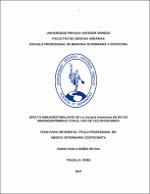Efecto inmunoestimulante de la uncaria tomentosa en ratas inmunodeprimidas con el uso de ciclofosfamida

View/
Download
(application/pdf: 2.444Mb)
(application/pdf: 2.444Mb)
Date
2021Author(s)
Núñez Reyna, Diana Paola
Metadata
Show full item recordAbstract
Con el objetivo de evaluar el efecto inmunoestimulante de la tintura de Uña de gato
(Uncaria tormentosa) en ratas inmunosuprimidas, se utilizaron 29 ratas albinas
machos, destetadas a los 30 días de nacidos, las cuales fueron distribuidas a través
de un diseño completamente al azar en cuatro tratamientos; grupo control
administrando NaCl vía intraperitoneal en reemplazo a la ciclofosfamida y vía oral
sustituyendo la Uña de gato (T1), grupo inmunosuprimido con ciclofosfamida a 2
dosis de 50 mg/kg y NaCl vía oral en reemplazo de la Uña de gato (T2), grupo
inmunosuprimido con ciclofosfamida a 2 dosis de 50 mg/kg y Uña de gato vía oral
100mg/kg (T3), grupo inmunosuprimido con ciclofosfamida a 2 dosis de 50mg/kg y
Uña de gato vía oral 200mg/kg (T4). A los grupos T3 y T4 se les administró la tintura
de Uña de gato por 15 días consecutivos, los grupos fueron evaluados al inicio (día
0) y final del experimento mediante hemogramas y celularidad de órganos linfoides
como médula ósea, timo y bazo (día 18). Los resultados fueron analizados mediante
el análisis de varianza y prueba de Tukey. En la seria roja no se apreciaron
diferencias significativas entre grupos de tratamientos, por otro lado se observó la
elevación de los valores leucocitarios como neutrófilos y linfocitos en los grupos T3
(100 mg/kg) y T4 (200 mg/kg), éste último sin diferencias significativas con el grupo
control T1(NaCl), aproximándose a los valores inicialmente obtenidos; de igual
forma en el conteo de células de los órganos linfoides, a pesar de no presentarse
diferencias significativas entre tratamientos, la dosis de 200 mg/kg (T4) de Uncaria
tormentosa mostró los mejores resultados en médula ósea y bazo, y la de 100
mg/kg en el timo, demostrando su efecto inmunoestimulante en relación a la dosis
administrada vía oral (dosis-dependiente) In order to evaluate the immunostimulant effect of Cat's Claw (Uncaria tormentosa)
tincture in immunosuppressed rats, 29 male albino rats, weaned at 30 days of birth,
were used, which were distributed through a completely randomized design in four
treatments; control group administering NaCl via intraperitoneal to replace
cyclophosphamide and orally to replace cat's claw (T1), immunosuppressed group
with cyclophosphamide at 2 doses of 50 mg /kg and NaCl administered orally to
replace cat's claw (T2), immunosuppressed group with cyclophosphamide at 2
doses of 50mg/kg and Cat's Claw oral route 100 mg/kg (T3), immunosuppressed
group with cyclophosphamide at 2 doses of 50 mg/kg and Cat's Claw oral route 200
mg/kg (T4). Cat's claw tincture was administered to groups T3 and T4 for 15
consecutive days, and the groups were evaluated at the beginning (day 0) and end
of the experiment by means of hemograms and cellularity of lymphoid organs such
as bone marrow, thymus and spleen (day 18). Results were analyzed by analysis of
variance and Tukey's test. In the red series, there were not significant differences
between treatment groups, on the other hand, it was observed the elevation of
leukocyte values such as neutrophils and lymphocytes in the groups T3 (100 mg/kg)
and T4 (200 mg/kg), this last one without significant differences with the control
group T1(NaCl), approaching the initially obtained values; Similarly, in the cell count
of lymphoid organs, despite no significant differences between treatments, the 200
mg/kg (T4) dose of Uncaria tormentosa showed the best results in bone marrow and
spleen, and the 100mg/kg in thymus, showing its immunostimulant effect in relation
to the dose administered orally (dose-dependent).
Subject
Collections
- Veterinaria y Zootecnia [197]

